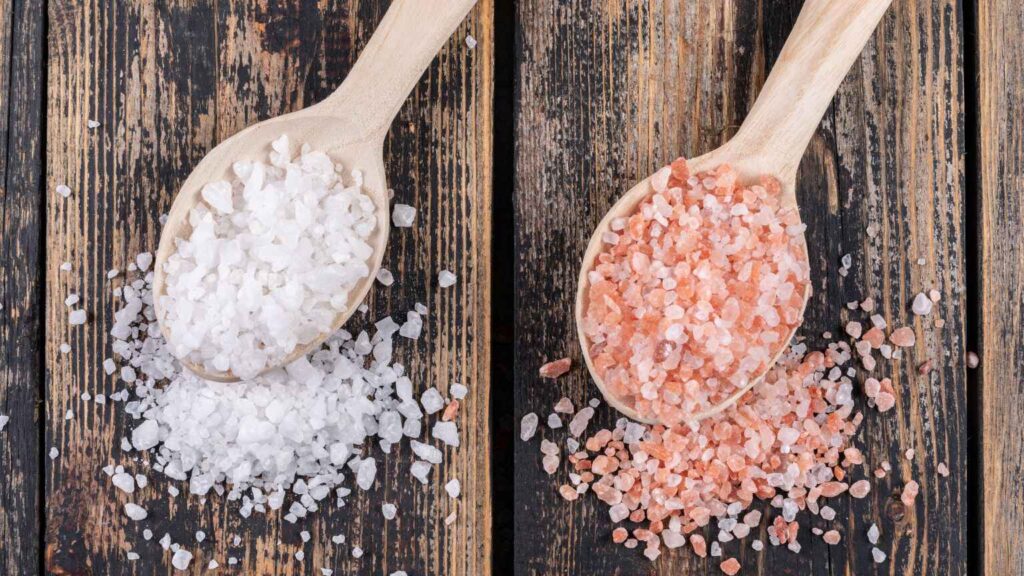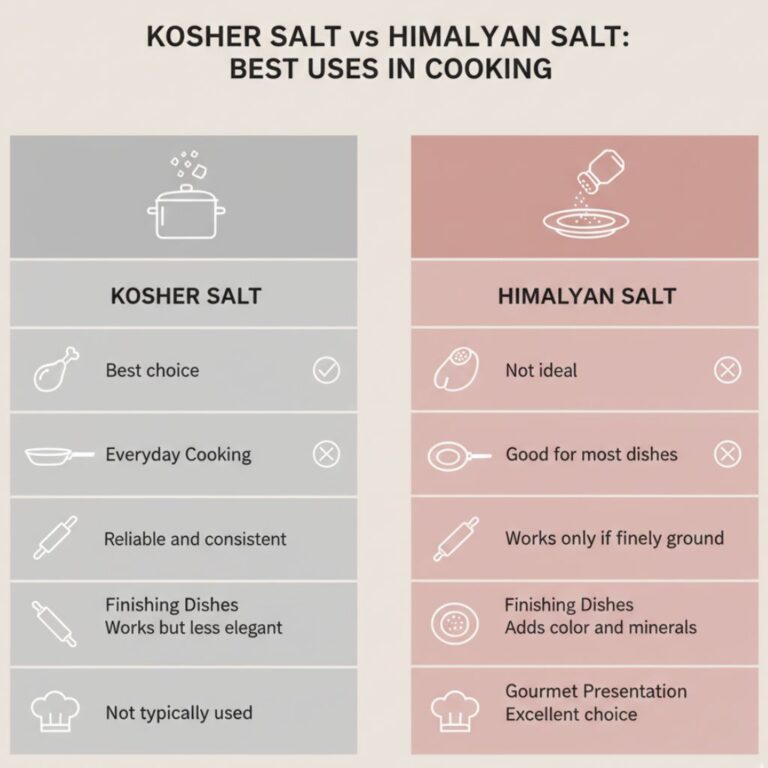Kosher Salt vs Himalayan Salt: Benefits, Uses, and Key Differences You Must Know
- Zayan Rauf

Salt has been a cornerstone of human civilization preserving food, enhancing flavor, and even holding cultural significance. Today, with so many salt varieties available, the debate often comes down to Kosher Salt vs Himalayan Salt. Both are widely used in kitchens and wellness practices, but how do they really compare?
In this guide, we’ll explore their origins, benefits, culinary uses, and health aspects—so you can decide which salt best fits your needs.
Table of Contents

What is Kosher Salt?
Kosher salt gets its name from its historical role in the Jewish practice of koshering meat, where its coarse grains made it ideal for drawing out blood. Unlike refined table salt, kosher salt is less processed and typically free of additives like anti-caking agents or iodine.
- Texture: Large, flaky crystals that are easy to pinch and measure.
- Flavor: Clean, pure salty taste without bitterness.
- Common Uses: Brining, seasoning meats, sprinkling on vegetables, and baking where precise salt distribution is important.
Because of its flakiness and ease of handling, professional chefs often prefer kosher salt in the kitchen.
What is Himalayan Salt?
Himalayan salt is mined from the ancient Khewra Salt Mines in Pakistan, dating back over 250 million years. Known for its natural pink hue, it owes its unique color to trace minerals like iron, magnesium, and potassium. A 2022 clinical trial in hypertensive women found no significant difference in blood pressure or urinary sodium between Himalayan salt and table salt, showing both have similar effects on heart health.[1]
- Appearance: Shades of pink to reddish due to mineral content.
- Processing: Hand-extracted, minimally refined, and often sold in large crystals.
- Uses Beyond Cooking: Salt lamps, spa treatments, salt caves, and salt blocks for grilling.
Unlike kosher salt, Himalayan salt carries a subtle mineral-rich flavor, which makes it popular both as a culinary finishing salt and in wellness traditions. Lab tests found Himalayan pink salt sometimes has higher fluoride levels than iodized salt, though values vary widely depending on the source. [2]
Did You Know?
Pink Himalayan salt is estimated to be over 250 million years old, formed from ancient seabeds trapped within the Himalayan mountains. [3]
Key Differences Between Kosher Salt and Himalayan Salt
Here’s a clear breakdown:
Feature | Kosher Salt | Himalayan Salt |
Origin | Modern refining, mainly from seawater or underground deposits | Ancient Khewra Salt Mines (Pakistan) |
Color | White | Pink to reddish |
Texture | Flaky, coarse, easy to pinch | Crystalline, harder, varying grain sizes |
Flavor | Clean, pure salty taste | Slightly mineral-rich, subtle complexity |
Mineral Content | Mostly sodium chloride | Contains trace minerals (iron, magnesium, calcium, potassium) |
Iodine | Usually non-iodized, unless fortified | Naturally iodine-free |
Best Uses | Cooking, baking, brining | Finishing dishes, wellness, decorative uses |
Cost | Affordable, widely available | More expensive, imported specialty salt |
Health Aspects: Which is Better?
When comparing kosher salt vs Himalayan salt for health, both have more similarities than differences:
- Sodium Content: Both provide roughly the same sodium per weight. The difference lies in grain size: kosher salt flakes are larger, so a teaspoon may contain less sodium than finely ground Himalayan salt.
- Minerals: Himalayan salt contains trace minerals like iron and magnesium, but in very small amounts not enough to significantly impact daily nutrition. A 2020 study analyzing 31 pink Himalayan salt samples in Australia confirmed higher levels of minerals like calcium and magnesium compared to table salt. However, the amounts per serving were negligible, and one sample even exceeded safe lead limits, highlighting the importance of trusted sourcing.[4]
- Iodine Content:
- Kosher salt: usually not iodized, but some brands may fortify.
- Himalayan salt: does not naturally contain iodine. If you rely only on Himalayan salt, ensure you get iodine from other sources (like seafood or fortified salt).
- Overall Health Impact: Neither is “healthier” in a dramatic sense; moderation is key. Animal studies in salt-sensitive rats have shown that natural sea salt (similar to unrefined Himalayan salt) causes less hypertension and kidney damage compared to refined table salt. While encouraging, more human studies are needed to confirm these effects. [5]
FAQ Highlight: Does Himalayan salt have iodine? → No, it does not. Kosher salt also usually lacks iodine unless fortified. A study in Jordan revealed many Himalayan and coarse salts contained iodine levels below recommended standards, making them less reliable for iodine intake compared to iodized table salt. [6]
Culinary Uses: When to Use Each Salt
1. Kosher Salt
- Excellent for brining meat due to large flakes.
- Preferred by chefs for seasoning during cooking because it’s easy to handle and spreads evenly.
- Works well in baking recipes where precise measurements matter.
Did You Know?
Kosher salt isn’t necessarily “kosher” by itself—it gets its name because its coarse texture was traditionally used in the koshering process of drawing blood from meat.[7]
2. Himalayan Salt
- Great as a finishing salt, adding visual appeal and subtle mineral flavor.
- Used on salt blocks for grilling, which imparts a unique taste.
- Popular in gourmet kitchens for adding a touch of elegance to salads, seafood, and desserts.
Conversion Tip:
If a recipe calls for 1 teaspoon of table salt, you’ll need about 1 ½ teaspoons of kosher salt or 1 teaspoon of finely ground Himalayan salt for similar flavor.
Quick Usage Table:
Use Case | Kosher Salt | Himalayan Salt |
Brining | Best choice due to large, flaky crystals | Not ideal because of dense crystal structure |
Everyday cooking | Excellent for general cooking and seasoning | Works well for everyday cooking too |
Baking | Reliable and commonly used in baking recipes | Can be used if finely ground |
Finishing dishes | Usable, but less appealing for presentation | Adds attractive color and subtle mineral taste |
Gourmet presentation | Not typically used for visual appeal | Excellent for gourmet plating and decoration |
Did You Know?
Despite popular belief, all salts—whether Himalayan, kosher, or sea salt—contain nearly the same amount of sodium chloride (about 97–99%), meaning moderation is still key for heart health. [8]
Cost, Quality, and Buying Tips
- Kosher Salt: Widely available and budget-friendly. A staple in most kitchens.
- Himalayan Salt: More expensive due to mining, transport, and marketing.
Quality Tip: Be cautious of imitation Himalayan salts that are artificially dyed. Genuine Himalayan salt should be naturally pink, sourced from Khewra mines.
Trusted companies like Sobaan Salts ensure authenticity and quality when purchasing Himalayan salt products.
FAQs
1. Does Himalayan salt have iodine?
No, Himalayan salt is naturally iodine-free. Ensure you get iodine from seafood, dairy, or iodized salt.
2. Is Himalayan salt healthier than kosher salt?
Not significantly. Both are mostly sodium chloride. Himalayan salt’s trace minerals don’t provide major health benefits in the small amounts consumed.
3. Which salt is best for everyday cooking?
Kosher salt is often better for cooking and baking due to its flakiness. Himalayan salt is great as a finishing or decorative salt.
4. Can I substitute kosher salt with Himalayan salt?
Yes, but adjust the quantity—Himalayan salt crystals are denser, so you may need slightly less.
Key Takeaways
- Kosher salt is affordable, versatile, and preferred for brining, cooking, and baking.
- Himalayan salt adds visual appeal, a subtle mineral taste, and is used in both cooking and wellness.
- Nutritionally, both salts are similar—sodium chloride with minor differences.
- Your choice depends on culinary needs, aesthetic preferences, and budget.
References:
1. Personal Injury Doctor Group. (2024, February 7). Comparing the Different Types of Salt and Their Health Benefits. Retrieved from
2. Library and Archives Canada. (n.d.). [Archived PDF resource]. Retrieved from
https://www.collectionscanada.gc.ca/obj/g4/14/780991915705_31051.pdf
3. Gale Health Reference Center Academic. (2023). Salt and Human Health. Retrieved from Google Scholar
4. Jurcan, C. (2014). Religion and Society: Theological Reflections in Contemporary Context. International Journal of Orthodox Theology, 3. Retrieved from
https://www.orthodox-theology.com/media/PDF/IJOT3.2014/Jurcan.pdf
5. ProQuest. (n.d.). Salt and Health: Scholarly Article. Retrieved from
https://www.proquest.com/openview/41bea238a11dc8c549b7c9e81f1bb428/1
Share This Post
Article By

